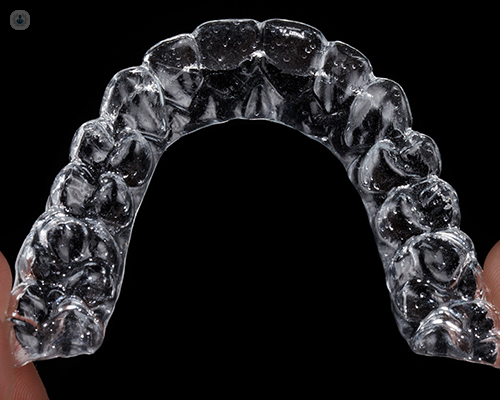An expert's guide to Invisalign
Escrito por:In his latest online article, leading Oxford-based dentist Dr Amir Mirzaei explains the popular teeth-straightening treatment, Invisalign. Dr Mirzaei tells us how this treatment works, whether or not it is effective and the advantages and disadvantages.

What is Invisalign?
Invisalign was the first brand of clear aligners that are used as an alternative to traditional metal braces to straighten teeth and correct various orthodontic issues. Unlike metal braces, which use brackets and wires to move teeth, Invisalign aligners are made of clear, flexible plastic that fits snugly over the teeth. Each aligner is precisely customised using the most accurate technology to fit comfortably.
How does Invisalign work?
Invisalign works by using a series of custom-made, clear plastic aligners to gradually move the teeth into their desired position. The process typically involves the following steps:
- Consultation and Treatment Plan: The first step is to consult with an orthodontist or dentist who is trained in Invisalign treatment. They will evaluate your teeth and create a customized treatment plan based on your specific needs.
- 3D Scanning and Aligner Design: The next step is to take 3D scans of your teeth, which are used to create a digital model of your mouth. The orthodontist or dentist then uses specialized software to design a series of aligners that will gradually shift your teeth into the desired position.
- Aligner Production: Once the aligner design is complete, a series of custom-made aligners are produced using a specialized manufacturing process. Each aligner is designed to fit snugly over your teeth, exerting gentle pressure to gradually move them into the desired position.
- Wearing the Aligners: You will wear each set of aligners for about 22 hours per day, removing them only to eat, drink, brush, and floss. Each set of aligners is worn for about 1-2 weeks before being replaced with the next set in the series. Over time, the aligners gradually shift your teeth into their desired position.
- Monitoring Progress: Throughout the treatment process, you will visit your orthodontist or dentist periodically to ensure that your treatment is progressing as planned. They may make adjustments to your treatment plan as needed to ensure that you achieve the best possible results.
Overall, Invisalign is an effective and discreet alternative to traditional braces that can help to straighten teeth and correct various orthodontic issues. However, it is important to consult with a qualified orthodontist or dentist to determine whether Invisalign is the right treatment option for your specific needs.
Is Invisalign effective?
Yes, Invisalign is an effective orthodontic treatment option for straightening teeth and correcting various orthodontic issues. Numerous clinical studies and patient testimonials have demonstrated the effectiveness of Invisalign for correcting a wide range of orthodontic problems, including crowding, spacing, overbite, underbite, and crossbite.
Invisalign's custom-made clear aligners gradually shift the teeth into their desired position, with each set of aligners being designed to apply the right amount of force to specific teeth at specific times during the treatment process. This precision and control can help to achieve more predictable and efficient results compared to traditional braces.

However, it is important to note that the effectiveness of Invisalign treatment depends on various factors, including the severity of the orthodontic issues being corrected, patient compliance with wearing the aligners as instructed, and the expertise and experience of the treating orthodontist or dentist. Additionally, some cases may still require traditional braces or other orthodontic treatment options for optimal results.
If you are considering Invisalign as a treatment option, it is important to consult with a qualified orthodontist or dentist to determine whether it is the right treatment option for your specific needs and to discuss your expectations and treatment goals.
Are there any advantages to using Invisalign?
Yes, there are several advantages to using Invisalign over traditional braces or other orthodontic treatment options. Here are some of the key advantages:
- Discreet: Invisalign aligners are made of clear plastic and are nearly invisible when worn, which can be particularly appealing for adults and teenagers who may feel self-conscious about wearing traditional metal braces.
- Comfortable: Invisalign aligners are custom-made to fit snugly over your teeth and are made of a smooth, flexible plastic material that is more comfortable than metal braces. Additionally, there are no wires or brackets that can irritate your mouth or cause discomfort.
- Removable: Invisalign aligners are removable, which means that you can take them out when eating, brushing, and flossing. This can make the treatment more convenient and comfortable than traditional braces, as there are no food restrictions and patients can maintain their regular oral hygiene routine.
- Predictable: Invisalign uses 3D imaging technology to create a customized treatment plan and aligner series that are tailored to your individual needs. This precision can help to achieve more predictable and efficient results compared to traditional braces.
- Fewer office visits: Invisalign treatment typically requires fewer office visits than traditional braces, as there are no adjustments to wires or brackets. Instead, patients receive several sets of aligners at each visit, which they change at home on their own.
Overall, Invisalign is a popular and effective orthodontic treatment option that offers several advantages over traditional braces or other treatment options. However, it is important to consult with a qualified orthodontist or dentist to determine whether Invisalign is the right treatment option for your specific needs.
Are there any disadvantages to using Invisalign?
While Invisalign is a highly effective and popular orthodontic treatment option, there are some potential disadvantages or limitations to consider. Here are a few:
- Compliance: Invisalign aligners must be worn for at least 22 hours a day to be effective, which means that patients must be diligent about wearing them as directed. Failure to wear the aligners as directed can result in slower progress and less effective treatment outcomes.
- Discipline: Since Invisalign aligners are removable, patients must have the discipline to keep track of them and keep them clean. If aligners are lost or not replaced on schedule, treatment progress can be disrupted.
- Cost: Invisalign treatment can be more expensive than traditional braces or other orthodontic treatment options, depending on the complexity of the case and the experience of the treating orthodontist or dentist. However, many dental insurance plans cover Invisalign treatment to some extent.
- Limited effectiveness in some cases: Invisalign may not be the best treatment option for all cases. Severe bite problems or significant tooth movement may require traditional braces or other orthodontic treatment options to achieve the desired results.
- Speech difficulties: Some patients may experience temporary speech difficulties when they first start wearing Invisalign aligners, due to the presence of a foreign object in the mouth. However, most patients adapt to the aligners quickly and speech difficulties resolve on their own.
It is important to discuss any concerns or questions you have about Invisalign treatment with a qualified orthodontist or dentist. They can evaluate your individual needs and recommend the best treatment options for your specific case.
Dr Amir Mirzaei is a leading dentist based in Oxford. If you would like to book an appointment with Dr Mirzaei you can do so today via his Top Doctors profile.



